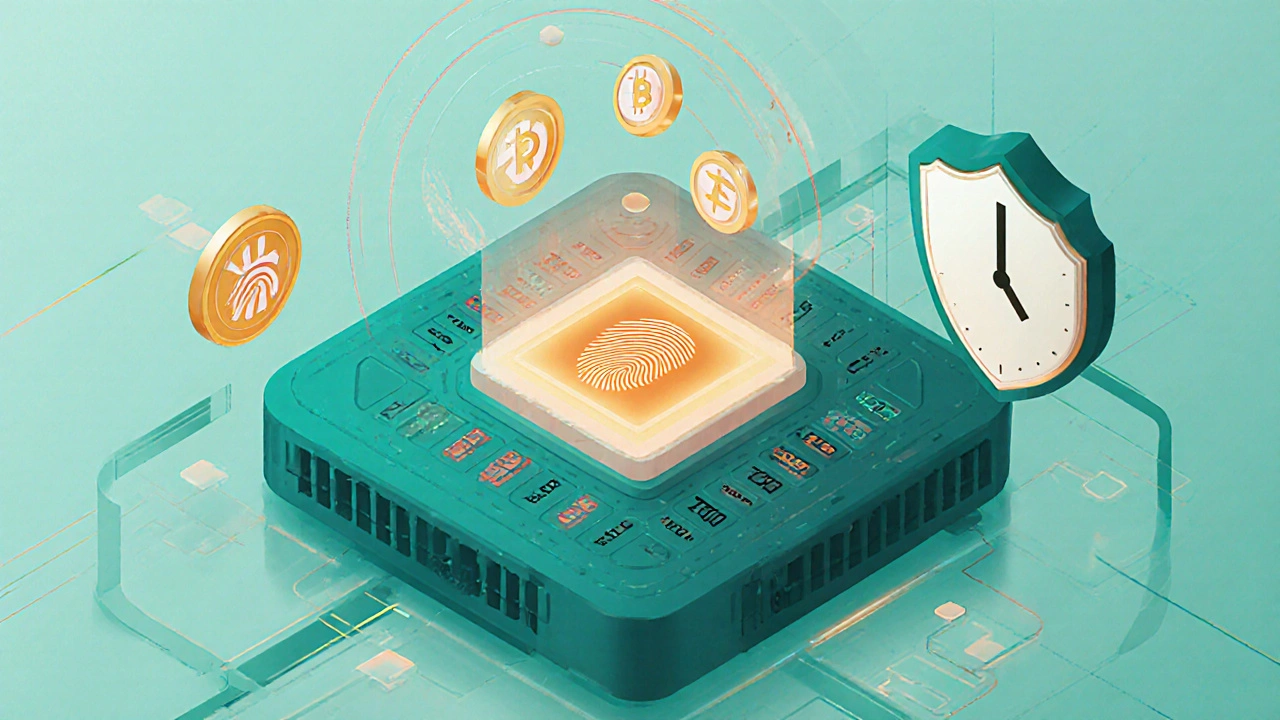Optimistic Rollups Explained: How They Speed Up Crypto Transactions
 Oct, 16 2025
Oct, 16 2025
When you hear the term optimistic rollups, you might picture a futuristic blockchain gadget, but the reality is a practical tool that makes crypto transactions faster and cheaper. In simple terms, optimistic rollups are a layer‑2 scaling technique that bundles many transactions together, processes them off the main chain, and then posts a single summary back to the base layer. This approach lets networks like Ethereum handle more activity without overloading the core protocol, while still keeping the security guarantees that users rely on.
What Exactly Is an Optimistic Rollup?
Optimistic Rollups is a layer‑2 scaling solution that batches transactions off‑chain and posts a validity claim to the main blockchain. The term "optimistic" comes from the assumption that batches are correct unless someone proves otherwise. This contrasts with "zero‑knowledge" rollups, which generate cryptographic proofs for every batch before it lands on‑chain.
Why Do We Need Optimistic Rollups?
- Ethereum’s base layer can only process about 15‑30 transactions per second (TPS), leading to high gas fees during peak demand.
- Developers and users want a smoother experience for DeFi, NFTs, and gaming without sacrificing security.
- Optimistic rollups allow thousands of transactions to be collapsed into a single rollup block, reducing the data that the main chain must verify.
The result? Lower fees, faster confirmations, and the ability for dApps to scale without waiting for major protocol upgrades.
How Does an Optimistic Rollup Work?
- Transaction Collection: A Sequencer-a specialized node-gathers user transactions off‑chain.
- Batch Execution: The sequencer runs these transactions using the same Smart Contracts logic as on the main network (often written in Solidity).
- State Commitment: After processing, the sequencer produces a state root-a cryptographic fingerprint of the new state-and posts it to the Ethereum mainnet along with a claim that the batch is valid.
- Fraud‑Proof Window: For a predefined period (usually 7 days), anyone can challenge the claim by submitting a Fraud Proof. If the challenge succeeds, the faulty sequencer is penalized, and the correct state is applied.
- Finality: If no valid challenge appears within the window, the batch is considered final, and the state root becomes part of the main chain.
This design means the network only needs to verify a single hash and any potential dispute, not every individual transaction.
Key Players: Optimism and Arbitrum
Two of the most widely adopted optimistic rollup implementations are Optimism and Arbitrum. Both aim to be EVM‑compatible, meaning developers can deploy existing Solidity contracts without changes.
- Optimism: Launched in 2021, Optimism focuses on simplicity and minimal changes to Ethereum’s core. Its dispute resolution uses a single‑step verification, which keeps gas costs low.
- Arbitrum: Introduced by Offchain Labs, Arbitrum adds a more flexible challenge system that can support multi‑step verification, offering stronger safety for complex contracts.
Both networks have seen massive adoption-Optimism’s TVL (total value locked) topped $8 billion in mid‑2025, while Arbitrum processed over 3 million transactions daily.
Optimistic Rollups vs. ZK Rollups: A Quick Comparison
| Feature | Optimistic Rollups | ZK Rollups |
|---|---|---|
| Validity Proof | Assumes validity; fraud proof needed if challenged | Zero‑knowledge proof generated for every batch |
| Finality Time | Typically 1‑7 days (challenge window) | Immediate (once proof verified) |
| Complexity of Contracts | Fully EVM‑compatible, supports all Solidity features | Currently limited for some complex operations |
| Gas Cost per Transaction | Low, but slightly higher than ZK due to challenge risk | Very low, proof amortizes cost |
| Security Model | Relies on honest majority of sequencers and challengers | Mathematically provable via zk‑SNARKs |
Both approaches aim to scale, yet they suit different use‑cases. Optimistic rollups excel when you need full compatibility with existing contracts; ZK rollups shine for high‑speed, low‑fee applications where immediate finality is crucial.

Benefits for End Users and Developers
- Reduced Gas Fees: By sharing a single proof across many transactions, users often pay a fraction of the cost they’d see on layer 1.
- Higher Throughput: Networks can handle tens of thousands of TPS, opening doors for gaming, micro‑payments, and large‑scale DeFi.
- Seamless Migration: Since most optimistic rollups are EVM‑compatible, developers can copy‑paste their Solidity code and redeploy within hours.
- Security Guarantees: Even if a sequencer behaves maliciously, the fraud‑proof system can roll back incorrect state, protecting funds.
These perks explain why major DeFi platforms-like Uniswap, Sushiswap, and Aave-have launched versions on Optimism and Arbitrum.
Potential Drawbacks and Risks
- Challenge Latency: The 7‑day window means users must wait longer for final settlement compared to ZK rollups.
- Economic Incentives: If the reward for submitting fraud proofs is too low, malicious sequencers might slip through.
- Centralization Concerns: Early rollup networks often start with a small set of sequencers, which could become points of failure.
- Complex Dispute Resolution: Developers need to understand how to design contracts that handle potential rollbacks gracefully.
Most of these issues are being addressed through community governance, larger validator sets, and improved incentive structures.
How to Get Started with Optimistic Rollups
- Choose a Rollup: For beginners, Optimism offers a straightforward onboarding flow; Arbitrum provides richer tooling for advanced contracts.
- Set Up a Wallet: Connect a compatible wallet (MetaMask, Rainbow, etc.) to the rollup’s network RPC endpoint.
- Bridge Funds: Use the official bridge to move ETH or ERC‑20 tokens from Ethereum mainnet to the rollup. Bridges typically charge a small fee and take a few minutes.
- Example: Transferring 0.5 ETH from Ethereum to Optimism costs ~0.001 ETH in combined fees.
- Interact with dApps: Visit a dApp that supports the rollup (e.g., Uniswap on Optimism) and start swapping with lower gas costs.
- Monitor the Challenge Window: If you’re a validator or simply curious, you can view pending fraud‑proof challenges on the rollup’s block explorer.
Following these steps, you’ll experience near‑instant transactions that would otherwise cost several dollars on Ethereum’s base layer.
Future Outlook: How Optimistic Rollups Fit Into Ethereum’s Roadmap
Ethereum’s long‑term plan-dubbed "Ethereum 2.0"-includes sharding, which will further increase base‑layer capacity. However, sharding is still years away from full deployment. In the meantime, optimistic rollups serve as a bridge, delivering immediate scalability while preserving the security of the main chain.
Upcoming upgrades like "Proto‑Danksharding" will make it easier to post rollup data, reducing costs even more. Projects are already experimenting with hybrid solutions, merging optimistic rollup data availability with zk‑proof verification to get the best of both worlds.
In short, optimistic rollups are not a temporary fix; they are an integral layer‑2 pillar that will coexist with future Ethereum upgrades, ensuring the ecosystem remains vibrant and accessible.

What makes optimistic rollups different from sidechains?
Sidechains run their own consensus mechanisms, meaning they are independent of the main chain’s security. Optimistic rollups, on the other hand, inherit Ethereum’s security by posting state commitments and allowing fraud proofs, so they remain trust‑less relative to the base layer.
How long is the fraud‑proof challenge period?
Most rollups set a 7‑day window, though some allow shorter periods (e.g., 2 days) for faster finality. The exact length is configurable by the rollup’s governance.
Can I use any Ethereum smart contract on an optimistic rollup?
Generally yes, because rollups aim for EVM compatibility. However, contracts that rely on block timestamps or gas‑heavy loops may need tweaking to avoid high costs or unexpected behavior during rollup batch execution.
What are the main security risks?
The primary risk is a malicious sequencer submitting an invalid state and evading detection if the fraud‑proof incentive is insufficient. Proper staking and penalties are crucial to mitigate this.
Where can I see the rollup’s transaction data?
Each rollup maintains its own block explorer (e.g., Optimism Explorer, Arbitrum Explorer) where you can view batch hashes, state roots, and any active fraud‑proof challenges.

Jen Kay
October 16, 2025 AT 13:17Thanks for breaking down the mechanics so clearly. It’s great to see the optimism (pun intended) behind rollups. While the tech sounds complex, the practical benefits are straightforward. Keep this level of detail coming; it helps newcomers not get lost in jargon. If anyone’s still skeptical about the 7‑day challenge window, just remember it’s a safety net, not a roadblock.
Michael Thomas
October 19, 2025 AT 20:53Optimistic rollups are just a band‑aid until Ethereum’s sharding arrives. They add latency and rely on questionable incentives. Bottom line: they’re not a long‑term solution.
Abert Canada
October 23, 2025 AT 08:13Honestly, I think the community has done a solid job making these rollups feel native. The EVM compatibility means devs can port their dApps without a headache. It’s also cool to see projects from different regions hopping on Optimism and Arbitrum. The cross‑border collaboration is what crypto needed. Let’s keep sharing best practices.
Xavier Lévesque
October 26, 2025 AT 18:33Sure, a week‑long challenge window sounds like a party, but hey, patience is a virtue. Rollups still manage to shave off those pricey gas spikes.
Scott Perlman
October 30, 2025 AT 05:53Optimistic rollups make cheap fast trades possible.
Sandi Johnson
November 2, 2025 AT 17:13Well, if you’re into waiting a week for finality, rollups are perfect for you. For the rest of us, the lower fees are a sweet deal. The fact that they inherit Ethereum’s security is a nice safety blanket. Still, the risk of a lazy sequencer slipping through is real – unless the bounty system is tuned right. I appreciate the transparent dispute mechanism, even if it feels a bit like a courtroom drama. Overall, they’re a pragmatic step forward.
Eva Monhaut
November 6, 2025 AT 04:33Reading through the overview, I’m reminded why optimism in crypto isn’t just a buzzword but a practical mindset.
The way optimistic rollups bundle transactions is essentially a massive batch recipe that the main chain only needs to taste.
By assuming correctness up front, they save the network from a costly verification step on every single operation.
That said, the seven‑day fraud‑proof window might feel like an eternity compared to the instant finality lovers crave.
However, the window acts as a democratic watchdog, letting anyone step up as a validator of honesty.
The incentives are cleverly designed so that honest challengers get rewarded while malicious sequencers risk slashing.
From a developer’s perspective, the EVM compatibility is a game‑changer because you can copy‑paste Solidity code without rewriting the logic.
I’ve seen projects migrate from L1 to Optimism and notice their gas fees drop from dollars to mere cents.
This cost reduction unlocks new use‑cases like micro‑payments and high‑frequency gaming that were previously uneconomical.
Moreover, because the rollup still posts a state root to Ethereum, the security guarantees remain as strong as the base layer.
The community governance models of Optimism and Arbitrum also illustrate how decentralized decision‑making can evolve.
Both networks are experimenting with larger validator sets to mitigate early centralization concerns.
Future upgrades like Proto‑Danksharding promise to lower data‑posting costs even further, making rollups even more attractive.
Imagine a world where you can swap tokens on a DEX with the speed of a centralized exchange but the trustlessness of Ethereum.
That vision is already materializing thanks to these optimistic layers, and the momentum doesn’t look like it will stall.
In short, optimistic rollups are not a stop‑gap; they are a foundational pillar for scaling the entire ecosystem.
mark nine
November 9, 2025 AT 15:53Agreed, the bounty system is key – if it’s too low, nobody bothers to challenge. In practice, we’ve seen decent payouts that keep the watchdogs honest. Just make sure to monitor the explorer for pending challenges.
Tony Smith
November 13, 2025 AT 03:13Indeed, while the poetic vision of fee‑free micro‑payments is alluring, one must not overlook the bureaucratic overhead of governance votes. The balance between decentralization and efficiency remains delicate. Nevertheless, the current trajectory suggests a pragmatic compromise.
Rakesh Kumar
November 16, 2025 AT 14:33The drama of governance meetings could rival a Shakespearean play, yet the stakes are real. Every vote shapes the future cost of a single transaction, and that’s nothing short of epic. Let’s hope the community writes a happy ending.